Today Samsung Electronics America released its second- generation quad-level cell (QLC) flash drive, the Samsung 870 QVO SATA SSD. While the original QLC release from Samsung went up to 4TB, the new 870 QVO can go up to 8TB. The new SSD is aimed at professional PC users delivering reliability and capacity they need for day to day usage.
QLC technology has been around for roughly two years now (out in the market, anyway). It allows vendors to add roughly 1/3 more density into their flash drives making larger capacity SSDs at a lower cost. There are a few performance hiccups along the way, but these drives more than outperform their HDD equivalents. QLC drives are even more attractive to the average portable PC user as they promise a best of both worlds approach with higher capacity in a 2.5″ form factor and better performance than any hard drive.
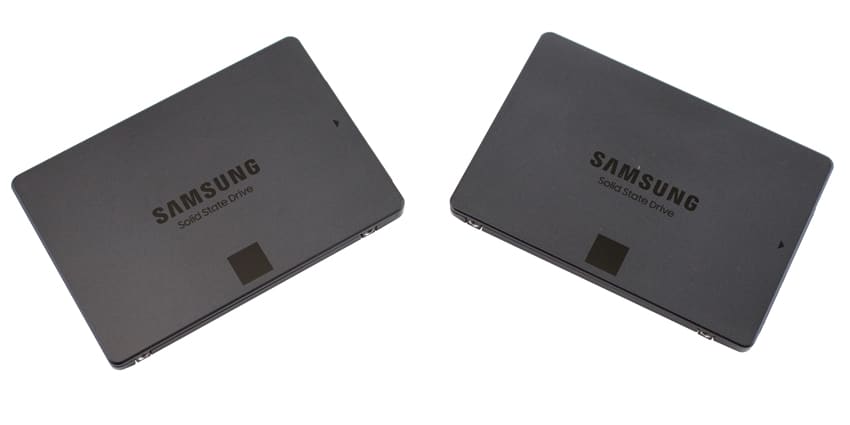
The Samsung 870 QVO is a SATA SSD that offers speeds up to 560MB/s read and 530MB/s write. The drive is able to hit these speeds and maintain them through its Intelligent TurboWrite technology that leverages a large variable SLC buffer. Samsung was able to get random reads improved by 13% making the drive appealing for those that multitask, game, or browse the web. For those looking to upgrade their optimize their SSD, they can leverage Samsung Magician 6. The 870 QVO also comes with good endurance with a quote of up to 2,880 terabytes written (TBW).
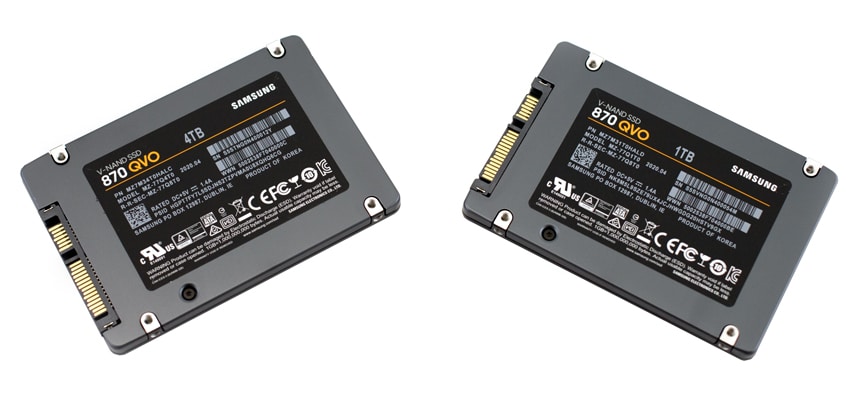
The Samsung 870 QVO comes with a 3-year limited warranty, ranges in capacity from 1TB to 8TB, with a MSRP starting at $130 for the 1TB. The 8TB model is expected in August of this year with pricing yet to come. For our review we will be looking at both the 1TB and 4TB models.
Samsung 870 QVO Specifications
| Interface | SATA 6 Gbps |
| Form Factor | 2.5-inch |
| Storage Memory | Samsung V-NAND 4-bit MLC (QLC) |
| Controller | Samsung MKX Controller |
| DRAM | 8GB LPDDR4 (8TB) 4GB LPDDR4 (4TB) 2GB LPDDR4 (2TB) 1GB LPDDR4 (1TB) |
| Capacity | 8TB, 4TB, 2TB, 1TB |
| Sequential Read/Write Speed | Up to 560/530 MB/s |
| Random Read/Write Speed | Up to 98K/88K IOPS |
| Management Software | Samsung Magician |
| Total Bytes Written | 2,880TB (8TB) 1,440TB (4TB) 720TB (2TB) 360TB (1TB) |
| Warranty | Three-year limited warranty |
Performance
Testbed
The test platform leveraged in these tests is a Dell PowerEdge R740xd server. We measure SAS and SATA performance through a Dell H730P RAID card inside this server, although we set the card in HBA mode only to disable the impact of RAID card cache. NVMe SSDs are tested natively through an M.2 to PCIe adapter card. The methodology used better reflects end-user workflow with the consistency, scalability and flexibility testing within virtualized server offers. A large focus is put on drive latency across the entire load range of the drive, not just at the smallest QD1 (Queue-Depth 1) levels. We do this because many of the common consumer benchmarks don’t adequately capture end-user workload profiles.
To more appropriately test the QLC-based SSDs we modified our consumer testing methodology to better reflect how these drives are designed to work out in the field. Compared to MLC or even TLC products, QLC-based SSDs have a very small continuous write ability. QLC SSDs mitigate this through adaptive SLC caching, but the short version of the story is after writing 10-15GB of data to the SSD at once, write speeds will drop from 1,500MB/s down to 100MB/s. Manufacturers see this drive instead working in burst activity, where users mostly read data from the drive, or write in chunks, allowing the drive to stay in the faster performance zone. To accommodate this workload, we modified our testing process to partition 1% of the drive surface, instead of 5% that we would traditionally test for a consumer product. In the case of the 1TB Samsung 870 QVO, this gives us a testing footprint of 10GB. We also don’t do a 100% prefill of the SSD before starting our workloads for QLC SSDs.
For comparison, we are comparing the new drives we have to the previous generation of Samsung QVO, the Samsung QVO 860. This makes a better comparison, versus running it up against the other QLC drives we have in stock that leverage the NVMe interface.
VDBench Workload Analysis
In our first VDBench Workload Analysis, we looked at random 4K read performance. Here, we see the 4TB and the 1TB 870 Samsung 870 QVO place better than the QVO 860 with the 1TB pulling into the lead. The 1TB peaked at 80,051 IOPS with a latency of 1.6ms and the 4TB peaked at 78,117 IOPS with a latency of 1.58ms before dropping off some.
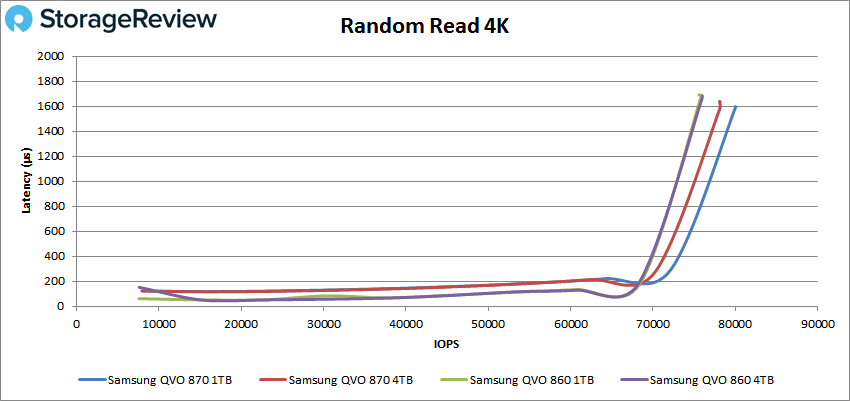
With random 4K write we saw all the drives cluster together for a very close finish. The 870 4TB peaked at 63,368 IOPS at a latency of 2ms while the 1TB version hit 63,292 IOPS with a latency of 2ms.
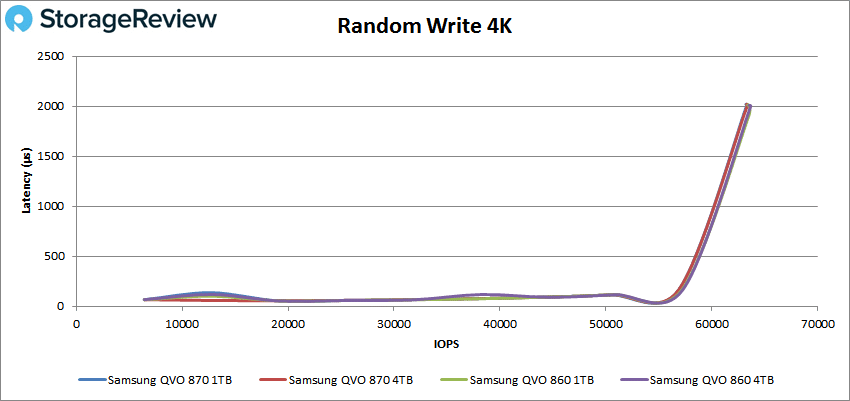
Switching over to sequential workloads, we first look at 64K read. Here the 870 drives showed better performance again both coming out to near the same on peak performance. The 4TB hit 7,887 IOPS or 493MB/s at a latency of 2ms. The 1TB was able to hit 7,941 IOPS or 496MB/s at a latency of 2ms.
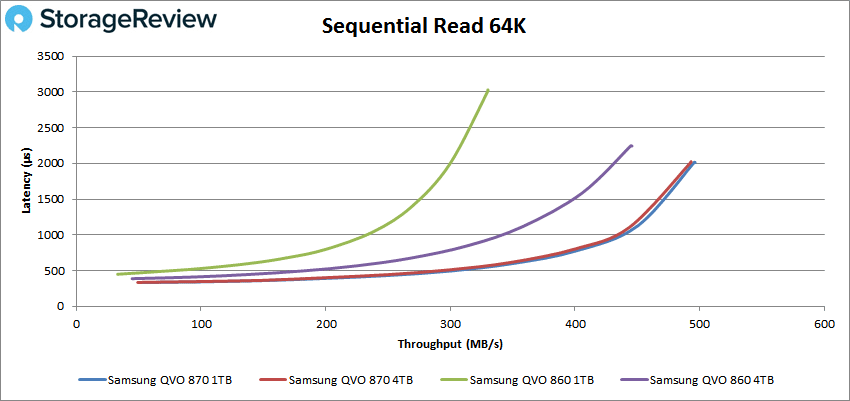
64K write saw all of the drives run together at peak again. Here the 4TB hit 6,676 IOPS or 417MB/s at a latency of 2.4ms. The 1TB hit 6,677 IOPS or 417MB/s at a latency of 2.4ms.
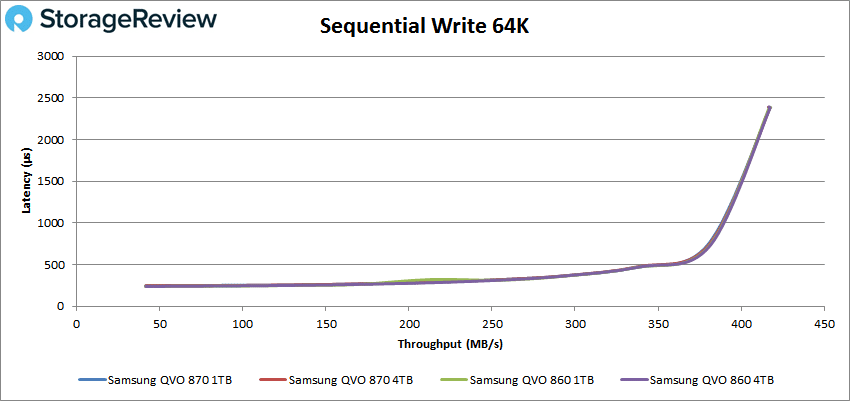
Next, we looked at our VDI benchmarks, which are designed to tax the drives even further. These tests include Boot, Initial Login, and Monday Login. Looking at the Boot test, it was a bit of a mixed bag. The Samsung 870 QVO 4TB took the top spot with a peak of 29,476 IOPS at a latency of 1.1ms before falling off some. The 1TB 870 took third with 25,548 IOPS with 1.23ms latency.
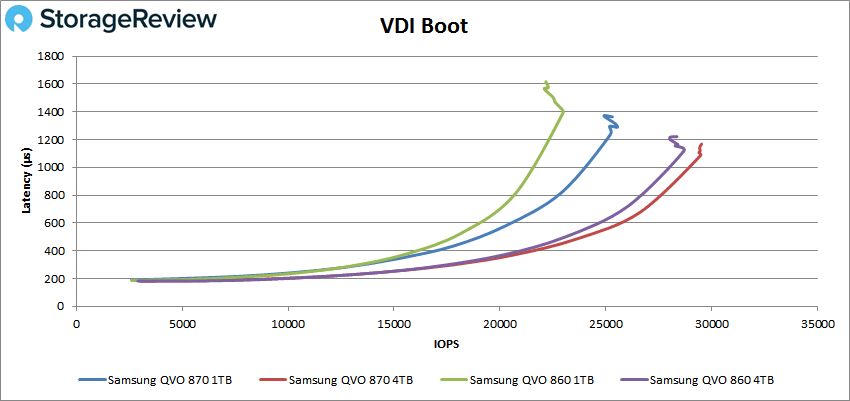
VDI Initial Login had all the drives run together again. Here the 4TB peaked at 20,674 IOPS at a latency of 1.44ms while the 1TB 20,594 IOPS at a latency of 1.5ms.
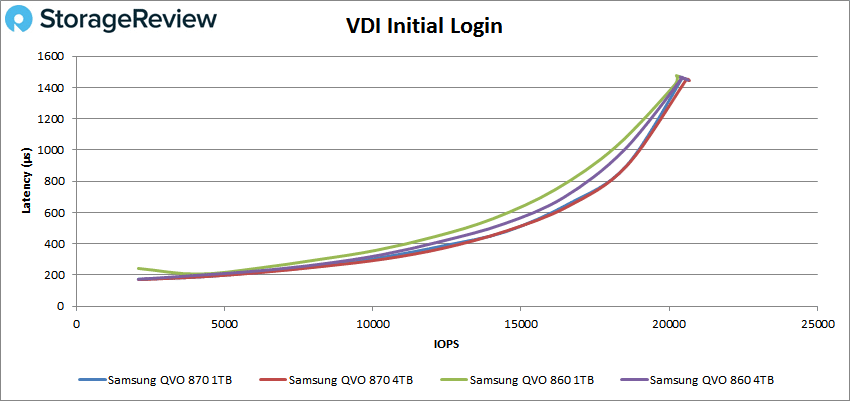
In VDI Monday Login the QVO 870 was able to pull ahead once more with the 4TB peaking at 18,149 IOPS at 878µs and the 1TB was able to hit 17,976 IOPS at 886µs for latency.
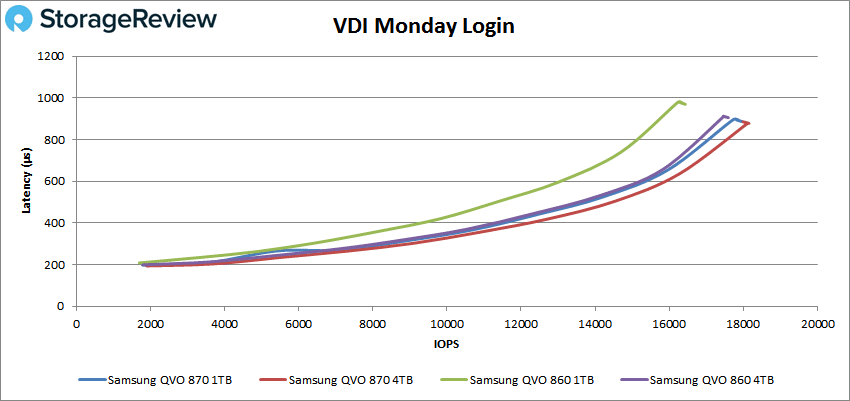
Conclusion
Samsung has released its second generation of QLC consumer drives with the Samsung 870 QVO. This SATA SSD leverages QLC technology to pack more density in the same foot print at a lower price point. The company can pack up to 8TB in a 2.5” form factor while still keeping speeds up around 560MB/s read and 530MB/s write. The drive is aimed at PC users looking to get more performance out of their storage while also adding more capacity, versus leveraging a HDD.
For performance we compared the current generation of Samsung QLC to the previous generation. For 4K random read we saw 63K IOPS, in 4K write both capacities hit about 7,900 IOPS, in 64K read we saw 493MB/s for the 4TB and 496MB/s for the 1TB, and 64K write we saw 417MB/s. For our VDI benchmarks the drives saw 29K IOPS for the 4TB and 26K IOPS with the 1TB for boot, Initial Login had them both about 21K IOPS, and Monday Login had both capacities at about 18K IOPS but with sub-millisecond latency.
The Samsung 870 QVO represents a great option for those looking for high capacity and good performance without breaking the bank. It’s a nice progressive improvement over the prior generation drive, showing there’s still a little life left still for SATA SSDs.




 Amazon
Amazon